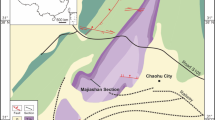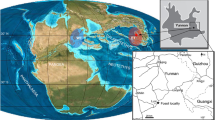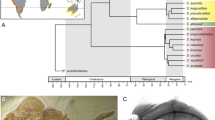Abstract
Reptiles constitute a primarily terrestrial assemblage, but several groups returned to the marine environment after the first appearance of reptiles in the late Palaeozoic era1. Successful diversification of the chelonioid sea turtles, particularly during the Cretaceous period, was perhaps one of the most important events in the history of turtles (and marine reptiles)2,3,4. The fossil record of chelonioids before the Late Cretaceous has been poorly documented. Here I report the discovery of an exceptionally well-preserved skeleton of the oldest known chelonioid, from the Early Cretaceous stage (about 110 million years before the present)5,6,7 of eastern Brazil. This specimen represents a new taxon, extending the history of chelonioids by 10 million years, and it sheds new light on the early evolution of the group. The limb of the specimen is a relatively primitive paddle, which still possesses movable digits as in freshwater turtles. However, the skull is specialized in the manner of later chelonioids, with large interorbital foramina that are indicative of huge lachrymal salt glands surrounding the eyes8,9. This discovery supports the idea that the establishment of the salt-excreting system, and the occupation of a marine habitat, may have preceded the formation of rigid paddles in the history of chelonioids.
This is a preview of subscription content, access via your institution
Access options
Subscribe to this journal
Receive 51 print issues and online access
$199.00 per year
only $3.90 per issue
Buy this article
- Purchase on Springer Link
- Instant access to full article PDF
Prices may be subject to local taxes which are calculated during checkout




Similar content being viewed by others
References
Carroll, R. L. Vertebrate Paleontology and Evolution (Freeman, New York, 1988).
Hirayama, R. Phylogenetic systematics of chelonioid sea turtles. Island Arc 3, 270–284 (1995).
Hirayama, R. & Chitoku, T. Family Dermochelyidae (Superfamily Chelonioidea) from the Upper Cretaceous of North Japan. Trans. Proc. Palaeontol. Soc. Japan 184, 597–622 (1996).
Hirayama, R. in Ancient Marine Reptiles (eds Callaway, J. L. & Nicholls, E. L.) 241–257 (Academic, San Diego, 1997).
Maisey, J. G. in Santana Fossils: An Illustrated Atlas (ed. Maisey, J. G.) 11–21 (TFH Publications, Neptune, NJ, 1991).
Martill, D. M. Fossils of the Santana and Crato Formations, Brazil. Palaeontol. Assoc. Field Guide Foss. 5, 1–159 (1993).
Meylan, P. A. Skeletal morphology and relationships of the Early Cretaceous side-necked turtle, Araripemys barrteoi (Testudines: Pelomedusoides: Araripemydidae), from the Santana Formation of Brazil. J. Vert. Paleontol. 16, 20–33 (1996).
Schmidt-Nielsen, K. & Fange, R. Salt glands in marine reptiles. Nature 183, 783–785 (1958).
Lutz, P. L. in The Biology of Sea Turtles (eds Lutz, P. L. & Musick, J. A.) 343–361 (CRC, New York, 1997).
Collins, J. I. The chelonian Rhinochelys Seeley from the Upper Cretaceous of England and France. Palaeontology 13, 355–378 (1970).
Zangerl, R. The vertebrate fauna of the Selma Formation of Alabama. Part 3. The turtles of the family Protostegidae. Part 4. The turtles of the family Toxochelyidae. Fieldiana Geol. Mem. 3, 61–277 (1953).
Shaffer, H. B., Meylan, P. & McKnight, M. L. Tests of turtle phylogeny: molecular, morphological, and paleontological approaches. Syst. Biol. 46, 235–268 (1997).
Walker, W. E. J in Biology of the Reptilia. 4 (eds Gans, C. & Parsons, T. S.) 1–100 (Academic, New York, 1973).
Gaffney, E. S. & Meylan, P. A. in The Phylogeny and Classification of Tetrapods. 1. Amphibians, Reptiles, Birds (ed. Benton, M. J.) 157–219 (Clarendon, Oxford, 1988).
Nessov, L. A. The Paleogene sea turtles of Southern Kazakhstan and the phylogenetic relationships between Toxochelyidae and the Cheloniidae. Paleontol. J. 21, 73–84 (1987).
Gaffney, E. S. Cranial morphology of the European Jurassic turtles Portlandemys and Plesiochelys. Bull. Am. Mus. Nat. Hist. 157, 489–543 (1976).
Gaffney, E. S. Comparative cranial morphology of recent and fossil turtles. Bull. Am. Mus. Nat. Hist. 164, 65–375 (1979).
Gaffney, E. S. The comparative osteology of the Triassic turtle Proganochelys. Bull. Am. Mus. Nat. Hist. 194, 1–263 (1990).
Schumacher, G.-H. Die Kopf- und Halsregion der Leder-schildkröte Dermochelys coriacea (Linnaeus 1976). Abhandl. Akad. Wissensch. 1972, 1–60 (1973).
Schumacher, G.-H. in Biology of the Reptilia. 4 (eds Gans, C. & Parsons, T. S.) 101–199 (Academic, New York, 1973).
Rieppel, O. The skull of the Upper Jurassic cryptodire turtle Thalassemys, with a reconsideration of the chelonian braincase. Palaeontogr. A 171, 105–140 (1980).
Zangerl, R. The vertebrate fauna of the Selma Formation of Alabama. Part 5. An advanced chelonioid sea turtle. Fieldiana Geol. Mem. 3, 61–277 (1960).
Acknowledgements
I thank F. Bacchia for field collection of the Santana turtles; E. S. Gaffney, P. E. Meylan and T. Hirayama for comments on manuscript; E. Hooks III for advice on protostegid morphology; D. B. Brinkman for comments on primitive eucryptodires; and N. Kohno for advice on the methodology of phylogenetic analysis. This work was partially supported by grants from the Teikyo Heisei University (formerly Teikyo University of Technology).
Author information
Authors and Affiliations
Corresponding author
Supplementary Information
Rights and permissions
About this article
Cite this article
Hirayama, R. Oldest known sea turtle. Nature 392, 705–708 (1998). https://doi.org/10.1038/33669
Received:
Accepted:
Issue Date:
DOI: https://doi.org/10.1038/33669
This article is cited by
-
A forged ‘chimera’ including the second specimen of the protostegid sea turtle Santanachelys gaffneyi and shell parts of the pleurodire Araripemys from the Lower Cretaceous Santana Group of Brazil
Swiss Journal of Palaeontology (2023)
-
A gigantic bizarre marine turtle (Testudines: Chelonioidea) from the Middle Campanian (Late Cretaceous) of South-western Europe
Scientific Reports (2022)
-
Olfaction of aquatic amniotes
Cell and Tissue Research (2021)
-
The locomotory apparatus and paraxial swimming in fossil and living marine reptiles: comparing Nothosauroidea, Plesiosauria, and Chelonioidea
PalZ (2021)
-
Fire in the paradise: evidence of repeated palaeo-wildfires from the Araripe Fossil Lagerstätte (Araripe Basin, Aptian-Albian), Northeast Brazil
Palaeobiodiversity and Palaeoenvironments (2019)
Comments
By submitting a comment you agree to abide by our Terms and Community Guidelines. If you find something abusive or that does not comply with our terms or guidelines please flag it as inappropriate.



